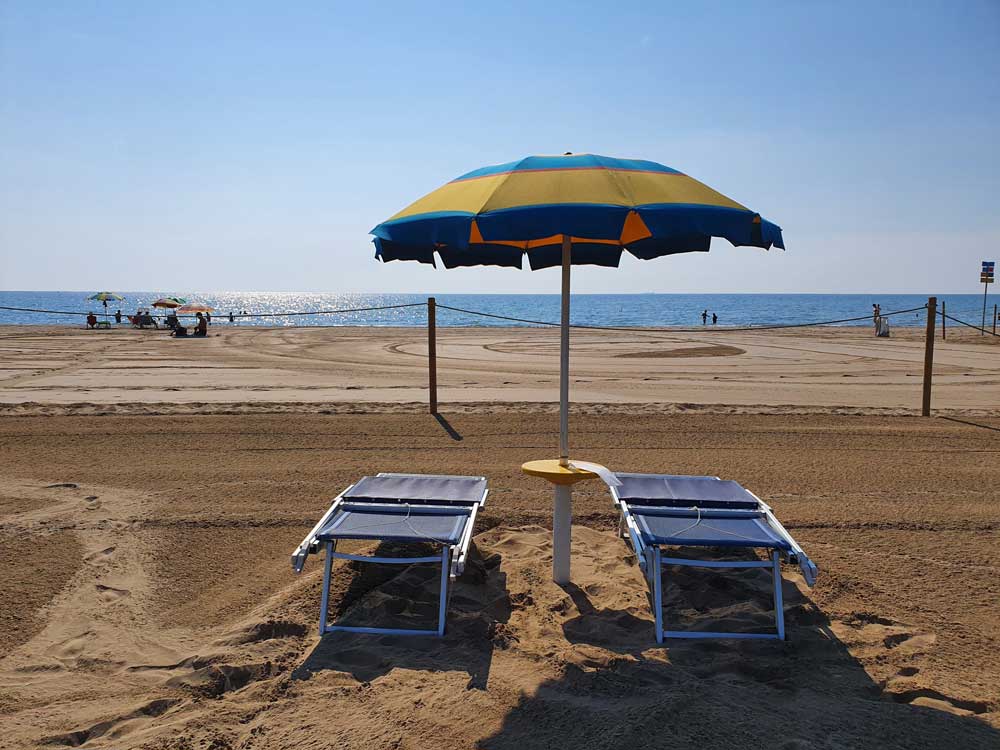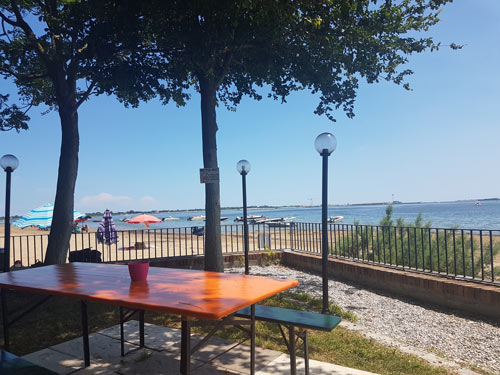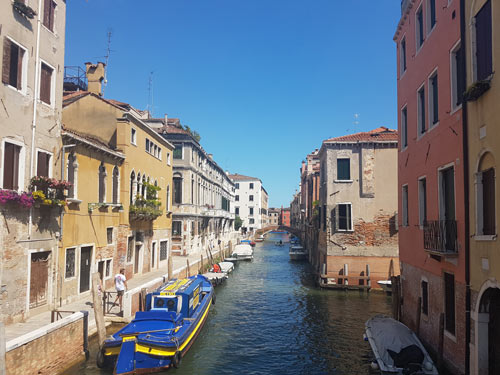Winter in Venice: December and January
Winter in Venice is cold but magical, as long as you’re prepared to wrap up warmly. I had liked the city on previous trips, but it was during a week in January that I fell in love. Of course there were tourists – there always are – but they were few and were mostly intent on their artistic itineraries. The streets were quiet, and local people went about their business or stopped to chat in the little squares. Some brave students huddled outside bars for their evening drinks; but most were tucked into the cosy interiors.
This is hot chocolate season; time to retreat into a snug cafe, sip a steaming hot chocolate and maybe read a Venetian book. Perhaps it’s over-romanticising, but at this time of year it’s easy to feel connected to the city and its past.

Although there may be brilliantly sunny days, the weather is likely to be grey and can be freezing. Venice gets very cold in winter, with a bitter edge to the damp air. You’ll need lots of layers of clothing and a hat. Photographs will probably be grey, although they can also be superbly atmospheric: misty views, snow falling on the Grand Canal, shallow floods in St. Mark’s Square (see our page on acqua alta). Less picturesquely, it seems to me that the streets aren’t kept as clean during the quiet season: there is more evidence of the local dogs. There are more winter tour groups now than there were when I first visited, but it is still much quieter than summer.
Good points: quiet streets; cheaper hotel rates; authentic local atmosphere; hot chocolate in cosy cafés; atmospheric photographs.
Bad points: it can be bitterly cold and you may be uncomfortable spending too long outdoors. Dog dirt.
February
February is Carnival time, so for two weeks the city is very busy and colourful. Accommodation is expensive and heavily-booked as tourists arrive to enjoy the spectacle. On Carnival weekdays the St. Mark’s area can actually be quite fun and manageable. But at the weekend hordes of day-trippers flood in by train and car, so the streets can get very crowded. Away from the masks and costumes though, the local areas of Venice are still quiet and peaceful. And outside Carnival fortnight, you can expect a more typical Venetian winter with prices to match.
Good points: the Carnival.
Bad points: the Carnival.
March and April

March and April can still be pretty cold and quiet in Venice. I’d recommend that you try to avoid the Easter break if possible, though, as the town is crushed under the weight of tourists arriving for Easter weekend – every European country is on holiday, and it feels as though most of them come to Venice. Although it can still be cold at night, spring makes itself felt with wisteria spilling over from hidden walled gardens and a good chance of sunshine. Local people gradually shed their thick winter coats.
Good points: sunshine; not too many crowds – as long as you avoid Easter.
Bad points: Easter is very busy, March is likely to be cold and April may still be cool.
May
May is an exciting month; when the cold has lifted and the sun becomes a daily visitor. The air is still fresh; hardy foreigners can head to the beaches on the Lido (where some businesses are still closed). May is really the best month for seeing Italy, with its sunshine, comfortable temperatures and flowers (not so many of these in Venice, of course).
In even-numbered years Venice hosts its Art Biennale, which runs approximately from May (sometimes slightly earlier or later) to late November. The first week of previews and openings can be a busy time with accommodation prices rising, luxury yachts in the lagoon, exclusive parties and inebriated hangers-on.
Good points: sunshine; comfortable climate. Tourist services are fully operational but without excessive crowds.
Bad points: practically none, unless you are longing to bask on the beach.
June
June is the start of summer and Italy braces itself for its first heatwaves. The weather is usually sunny and fine, although it can begin to reach uncomfortable levels of heat. This is your last chance to visit before the real peak summer season. There should still be space on beaches and in the city, especially on weekdays.
Good points: warm weather; sunshine.
Bad points: possibility of heatwaves.
July

By July the hot weather is generally established. Mid-July is the start of the summer holidays for most European nations (who go on holiday at the same time regardless of whether they have school-age children). The Lido and the seaside resorts near the lagoon fill up with sunbathing families. The Festa del Redentore, which takes place on the third weekend of the month, is a massive party for Venetians. Tourists will enjoy the spectacle, but may be frustrated by the accompanying transport disruptions and early-closing businesses on that weekend. The lagoon’s mosquitoes are likely to be out in force by now.
Good points: Festa del Redentore; sunshine.
Bad points: crowds; daytrippers; heat; mosquitoes.
> Summer in Venice: how to enjoy it
> Where to stay in Venice in summer (blog article)
August
August is a strange month in Venice. Some tourists are kept away by tales of smelly canals, oppressive heat and horrible crowds, but others still flock in. You may encounter the odd whiff around Venice – stale damp smells in dark and narrow alleys, for example – but there is really nothing like those myths you may have heard. The city is reasonably hygienic nowadays.
True, it can be very hot. And there are certainly large crowds of tourists, many of them families flocking in for day trips from their holiday spots outside town. The most striking thing, though, is the absence of locals. Italians pack up and go on holiday in July and August, sometimes for more than a month. In residential parts of Venice you’ll see shuttered buildings, shops and restaurants. Many businesses close for at least a fortnight – usually around the holiday peak of Ferragosto, the 15th August – and if you are looking for an affordable meal or ordinary shops you can become frustrated. Tourist businesses tend to stay open, but many of those serving residents don’t.
More than any other time of year, Venice feels like a Disneyland where tourists have displaced locals. Unless you have no choice, I wouldn’t advise Venice in August, especially if it is your first trip and you plan to visit the main tourist sights. You won’t be seeing the city at its best. If you do visit in the height of summer, you’ll want to escape from the crowds: consider booking a hotel in a quiet area, spending time on the beach, and taking trips to unusual, non-touristy spots like the island of Sant’Erasmo.
Good points: Not many. The weather should be hot. The lagoon islands and Lido beach make refreshing get-aways.
Bad points: like July: crowds, daytrippers, heat, mosquitoes. ‘Local’ Venice is away on holiday.

September
The Venice Film Festival takes place on the Lido at the end of August / beginning of September, lasting a week and a half. This doesn’t make much of a difference to the main part of Venice, although you may find that expensive hotels are booked up by film industry visitors. The city comes back to life as Venetians return from their summer holidays and re-open their businesses.
The weather is enormously variable. You may enjoy a late burst of summer, but temperatures can get much cooler, especially at night. Sudden rainstorms are a feature of autumn in Italy, and these can be devastatingly heavy. Mosquitoes are another hazard of the season; and visitors are well-advised to take precautions against bites.
This is generally quite a good time to see Venice, though. You are likely to enjoy some sunshine and blue skies, without the crush of crowds or sweltering heat of high summer.
Good points: slightly quieter than August; local businesses re-open; the Film Festival.
Bad points: occasional heavy showers; mosquitoes.
October
October is a transitional month, before the arrival of the truly cold winter. The acqua alta season is under way so there may be some flooding during exceptionally high tides (around a full or new moon). Visitors will want to bring warm clothing, especially for the evenings, although layering is probably the key. Venice is a university town so you may notice gaggles of new students outside Dorsoduro bars.
Good points: fewer tourists.
Bad points: colder nights; those pesky mosquitoes are still in action.
November
November is the start of the winter, although generally less bitter than January and February. It’s time to start appreciating the wonderfully rich drinks of hot chocolate that Venetians have enjoyed for centuries (Casanova swore by it).
The Art Biennale (in odd-numbered years) draws to a close, although the music and theatre seasons are under way for those who fancy a dose of culture. On 21st November the festival of the Salute is celebrated, with a temporary bridge over the Grand Canal to the Salute church and a special mass.
Good points: Venice begins to feel like a ‘local’ town.
Bad points: cold temperatures and grey skies.
> When should I visit Venice? – a light-hearted quiz
> Venice in winter
> Venice in summer
> Where to stay in Venice in summer
